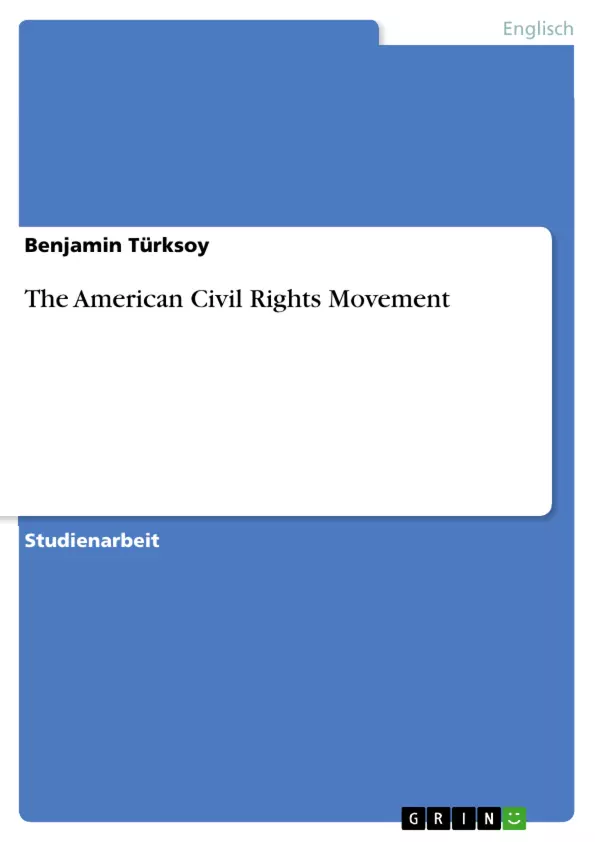In March 1958, a pacifistic group named “The Fellowship of Reconciliation” that had provided most of CORE’s early leaders sent James Lawson to Nashville to lead a workshop in non-violence for African-American activists. A year later, as a divinity student at Nashville’s Vanderbilt University, Lawson drew a small but morally charged number of young men and women from the black colleges to his regular training sessions in non-violent protest1. In the fall of 1959, this Nashville student group stages test sit-ins at segregated city restaurants and lunch counters. Staying just long enough to draw refusal of service, they failed either to change management policy or to draw others into the protest. Lawson had outrun the zeitgeist by a few months. With the Greensboro sit-ins of February 1960, though, the Nashville group acquired a prophetic luster. Soon Lawson was directing hundreds of students who volunteered in disciplined protests against segregation in downtown stores.
Inhaltsverzeichnis
- The Sit-ins
- The Freedom Rides
- The March on Washington
- The Black Panther Party
- Theory
- 10-Point-Program
- Actions
- Watts Riots
- What happened
- Responses to Watts
- Summary
Zielsetzung und Themenschwerpunkte
Der Text befasst sich mit wichtigen Ereignissen der Bürgerrechtsbewegung in den USA während der 1960er Jahre. Er beleuchtet die verschiedenen Strategien und Aktionen von Aktivisten und Organisationen, die sich für die Gleichberechtigung von Afroamerikanern einsetzten.
- Die Bedeutung von gewaltlosen Protesten
- Die Rolle von Studenten in der Bürgerrechtsbewegung
- Der Einfluss von staatlicher Gewalt und Rassismus in den Südstaaten
- Die Reaktion der Öffentlichkeit und der Medien auf die Bürgerrechtsbewegung
- Die Herausforderungen und Erfolge der Bewegung im Kampf gegen die Segregation
Zusammenfassung der Kapitel
The Sit-ins
Das Kapitel beschreibt die Entstehung der Sit-in-Bewegung in den 1960er Jahren und ihre Auswirkungen auf die Segregationspolitik in den Südstaaten. Es beleuchtet die strategische Nutzung von gewaltlosen Protesten, die Reaktionen der Behörden und die Rolle von Studenten in der Bewegung.
The Freedom Rides
Dieses Kapitel widmet sich den Freedom Rides, interracialen Busreisen durch den Süden, die darauf zielten, die Segregation in öffentlichen Verkehrsmitteln zu beenden. Es schildert die Herausforderungen und Gefahren, denen sich die Aktivisten stellten, und die Reaktion der Behörden auf diese Protestaktionen.
The March on Washington
Das Kapitel behandelt den "Marsch auf Washington für Arbeit und Freiheit", eine große Demonstration für Bürgerrechte im August 1963. Es beleuchtet die Bedeutung dieses historischen Ereignisses, die Reden der prominenten Redner und die Auswirkungen auf die öffentliche Meinung.
The Black Panther Party
Dieses Kapitel geht auf die Black Panther Party ein, eine radikale afroamerikanische Bürgerrechtsorganisation, die sich für Selbstverteidigung und politische Selbstbestimmung einsetzte. Es beschreibt die Ideologie der Black Panther Party, ihre Forderungen und ihre Aktionen.
Watts Riots
Das Kapitel beschreibt die Unruhen in Watts, einem afroamerikanischen Viertel in Los Angeles im Jahr 1965. Es schildert die Ereignisse, die zu den Unruhen führten, die Reaktion der Polizei und der Behörden, sowie die Auswirkungen auf die afroamerikanische Gemeinschaft.
Schlüsselwörter
Die Schlüsselwörter des Textes sind: Bürgerrechtsbewegung, Segregation, Rassismus, gewaltlose Proteste, Sit-ins, Freedom Rides, March on Washington, Black Panther Party, Watts Riots, Selbstverteidigung, politische Selbstbestimmung, Gleichberechtigung.
- Quote paper
- Benjamin Türksoy (Author), 2006, The American Civil Rights Movement, Munich, GRIN Verlag, https://www.grin.com/document/189740



